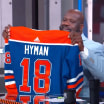At age 20 last season, Horvat had 40 points in 82 games, which exceeded the scoring totals of Daniel and Henrik at that age; in 2000-01, Daniel had 34 points, Henrik had 29. The last Canucks player age 20 or younger with more than 40 points in a season was Pavel Bure (60 points in 65 games in 1991-92).
At age 21 in 2001-02, Daniel had 32 points and Henrik had 36. This season, Horvat is on pace for 53 points. The last time a Vancouver player age 21 or younger had 54 points in a season was in 1992-93, when Bure had 110 and Petr Nedved had 71.
When comparing these scoring totals to Horvat's, it's important to note how much easier scoring was in the earlier era: There was an average of more than 7.0 goals per game in the early 1990s, compared to 5.5 goals per game this season.
It's also worth noting that Horvat can contribute scoring while killing penalties and centering a line with significant defensive responsibilities.
As a rookie in 2014-15, Horvat played on a depth line with Jannik Hansen on one wing and either Derek Dorsett or Ronalds Kenins on the other. An injury to center Brandon Sutter resulted in a promotion for Horvat to the second line behind the Sedins in 2015-16. The results of this challenge were mixed, and Horvat finished minus-30, tied for second-worst in the NHL (Mikkel Boedker was minus-33 with the Arizona Coyotes and Colorado Avalanche).
When placed in the proper context, Horvat's poor numbers may have been a reflection of the tough minutes he was assigned. He was skating with equally inexperienced players (Sven Baertschi, who to that point had played 69 NHL games), and was tasked with taking on top opponents in defensive-zone situations.
At even strength, Horvat started 315 shifts in the offensive zone and 431 in the defensive zone, for a zone-start percentage of 42.23 percent that was second-lowest among Canucks forwards to play at least 20 games, ahead of Brendan Gaunce (41.35 percent). By comparison, Henrik Sedin was at 59.46 percent and Daniel Sedin was at 58.83 percent.
Horvat also led Canucks forwards with an average of 2:15 of shorthanded ice time per game.


















